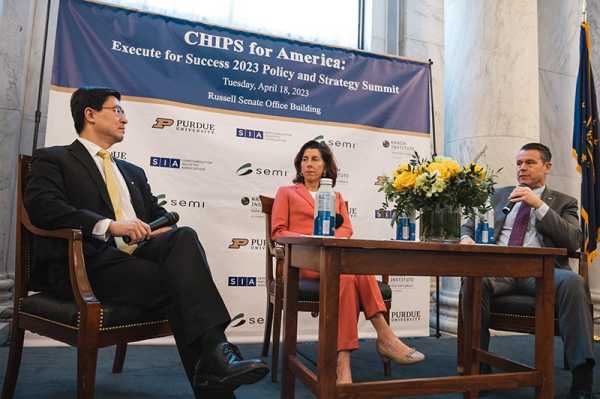
Leaders from industry, government and academia gathered for a summit Tuesday (April 18) in Washington, D.C. to develop sweeping national solutions to address the future of America's microelectronics innovation and semiconductor workforce.

Purdue University President Mung Chiang, U.S. Commerce Secretary Gina Raimondo and U.S. Sen. Todd Young of Indiana on stage at the CHIPS for America conference in Washington, D.C. on Tuesday (April 18). (photo by Purdue University)
The day-long CHIPS for America: Execute for Success Summit in Washington, D.C., led by Perdue and U.S. Sen. Todd Young of Indiana at the Russell Senate Office Building in Washington, D.C., drew hundreds of participants representing more than 175 organizations from over 23 states and focused on strategies to realize the vision outlined in the recently released CHIPS for America: A Vision for Success. He highlighted implementation of federal investments and future policy actions, and fostered government, industry and academic partnerships with a particular focus on workforce development and research innovation.
President Mung Chiang and Chief Semiconductor Officer Mark Lundstrom represented Purdue, which is partnering with SEMI, the Semiconductor Industry Association and Purdue's Krach Institute for Technology Diplomacy to host the summit.
Keynote for the day, Chiang held a fireside chat with U.S. Commerce Secretary Gina Raimondo and Senator Young, and several panel discussions featured leaders from industry, government and academia sharing their perspectives on how best to realize the vision of workforce development and science. -research works in accordance with the CHIPS law. ;D programs.
"This is our silicon moment to execute the CHIPS Act for Success," Chiang said. "As we mark 75 years since the invention of the transistor at Bell Labs, we can only imagine what the next 75 years of semiconductor innovation might look like."
Raimondo, who visited Purdue in the fall of 2022 with U.S. Secretary of State Anthony Blinken, said at the summit: “I was impressed with what I saw when I visited Purdue because, in my opinion, this is exactly what the United States should be doing. A truly robust partnership between leading research universities like Purdue and industry, and the integration of local colleges and high schools.”
She added, "More people should continue to do what Purdue is doing: allowing students to put in applied work at companies, allowing companies to enter universities, making sure students are ready to work after graduation."
Reflecting on Raimondo and Blinken's visit to Purdue last September, Young said, “There's a lot of excitement in the air about what might happen next. … What encouraged me at the end of this meeting is that our state has really realized many opportunities. We are putting together a technical center package. Purdue University and several other institutions are developing new workforce training programs for these key sectors. Indiana is really poised to play a (significant) role in semiconductors as well as any other emerging technologies that we need to invest in.”
Other speakers at the summit included Ramin Tolui, Assistant Secretary of State for Economic and Business Affairs at the US Department of State; Dr. Dev Shenoy, Principal Director, Microelectronics Division, US Department of Defense; Dr. Eric Lin, Interim Director, CHIPS Research and Development, US Department of Commerce; and Dr. Erwin Gianchandani, Assistant Director of Technology, Innovation and Partnerships at the National Science Foundation, as well as executives from Applied Materials, Everspin Technologies, the Information Technology and Innovation Foundation, Intel, Micron, SEMI, the Semiconductor Industry Association, Semiconductor Research Corporation, and SkyWater. They shared their views on the challenges ahead, ways to measure progress and how to sustain efforts in the long term. Barbara Snyder, president of the Association of American Universities, offered closing remarks about the many roles that a leading research university like Purdue plays in the success of the CHIPS Act.
Semiconductor Target Group and Sustainability Index
strong>
At the start of a fireside chat with Raimondo and Yang, Chiang announced a partnership with industry to create the Semiconductor Sustainability Index (SCSI) with a vision to integrate and operationalize green design principles and practices throughout the semiconductor industry. The effort calls for addressing the economic, environmental, and social dimensions of sustainability in the design of materials, processes, systems, products, supply chains, and enterprises. The Sustainable Semiconductor Manufacturing Initiative builds on decades of knowledge and experience from faculty across the university. They include some of the world's leading experts in industrial sustainability and semiconductor design/manufacturing.
Carol Handwerker, Reinhardt Schumann Jr. Professor of Materials Science and Professor of Environmental and Environmental Engineering, notes that “the initiative leverages ongoing industry collaboration with the SEMI Climate Consortium, imec, SkyWater, Seagate, Google, Microsoft, Cisco, and more. » Moving forward, this initiative will include sustainability education and workforce development, as well as improving process and product design through sustainability-focused research innovation.
Additionally, this week Purdue announced the creation of the Purdue Presidential Semiconductor Task. Force is led by Lundstrom, the university's first semiconductor director, who will coordinate and lead Purdue's innovative research and development efforts in semiconductors.
Lundstrom said the CHIPS Act is a unique investment that provides an opportunity to strengthen the continued work of educators to launch the nation's largest and most comprehensive workforce development program. It also spurred Purdue's plans for new, innovative research programs and its collaboration with Indiana State to develop a new semiconductor ecosystem.
More than 25 companies that have members on the Purdue Semiconductor Degrees Leadership Board sent industry representatives to the summit and met with Purdue staff afterward. The board was established to ensure future contributions to Purdue's semiconductor degree program.
Developing Purdue's National Leadership: Phase 1 of Semiconductor Manufacturing Moving Forward
As part of Purdue Computes, a three-pronged strategic initiative launched April 14 to further scale Purdue's research and education efforts in the future of computing, and recognizing that computing happens on chips, Purdue announced a $49 million Phase 1 investment in semiconductors. cleanroom upgrades and a planned Phase 2 for another $51 million to help create an open innovation ecosystem.

Purdue invests $49 million in Birk Center for Nanotechnology, including cleanrooms, one of the largest academic cleanrooms in the nation
"The Birck Center for Nanotechnology has been a critical home for discovery and technology development for decades, both for Purdue researchers and for industry and other universities that use our facilities," said Zhihong Chen, Mary Jo and Robert L. Kirk Birck Director. Nanotechnology Center. "This investment ensures that we will maintain our state-of-the-art facilities, restore more space and create new opportunities for semiconductor research and development."
The upgrade will include the acquisition of specialized equipment to fabricate and characterize the devices, as well as efforts to increase the capacity of the Scifres Nanofabrication Laboratory's 25,000-square-foot cleanroom, one of the largest academic cleanrooms in the country. It will include a dedicated training platform to train those in the university's semiconductor program, such as Purdue students, Ivy Tech students and engineers in the field.
The upgrades will also create dedicated cleanrooms and labs for advanced packaging research – innovations in design, materials and processing that are needed to integrate chiplets with different functions – and shared quantum transport and characterization facilities that are important for future electronic and quantum information applications. Work will begin immediately and is expected to be completed in August 2024. Installation of new equipment in the renovated premises will begin in the first quarter of 2024.
"As we continue to push the boundaries of scientific discovery, our commitment to advancing nanoscale science and engineering is unwavering," said Karen Plaut, Executive Vice President of Research. "Purdue's investment in our facilities demonstrates our commitment to providing state-of-the-art resources for our valued researchers and students, enabling them to develop important semiconductor technologies and participate in groundbreaking research in other areas of nanoelectronics, quantum computing, and more." "
Source: electronicproducts.com










